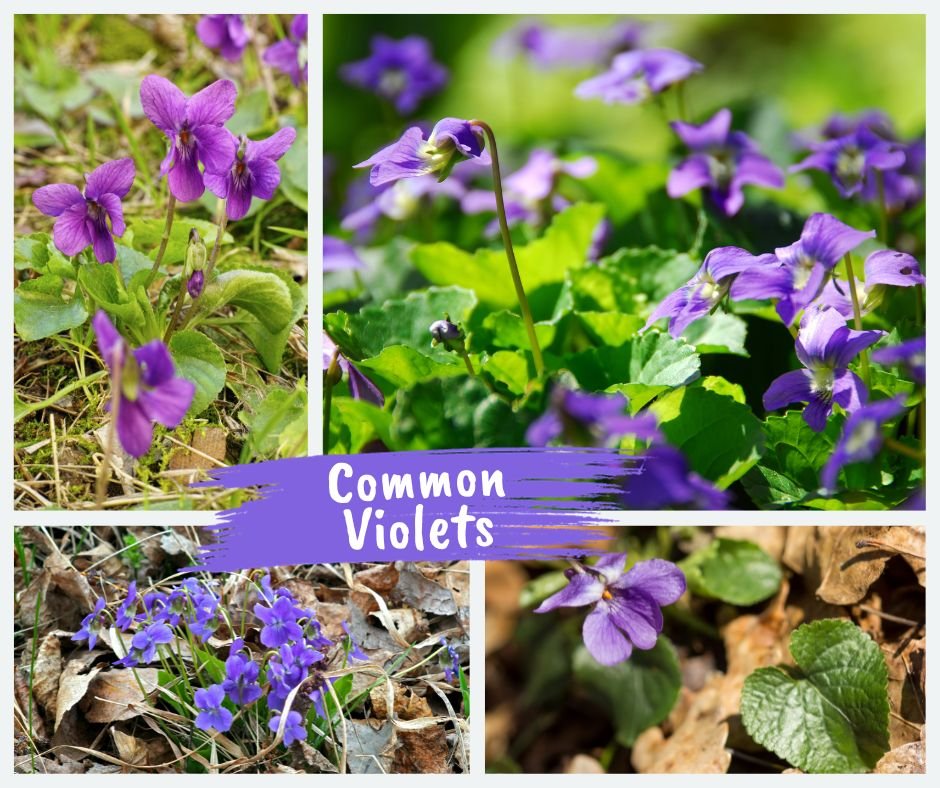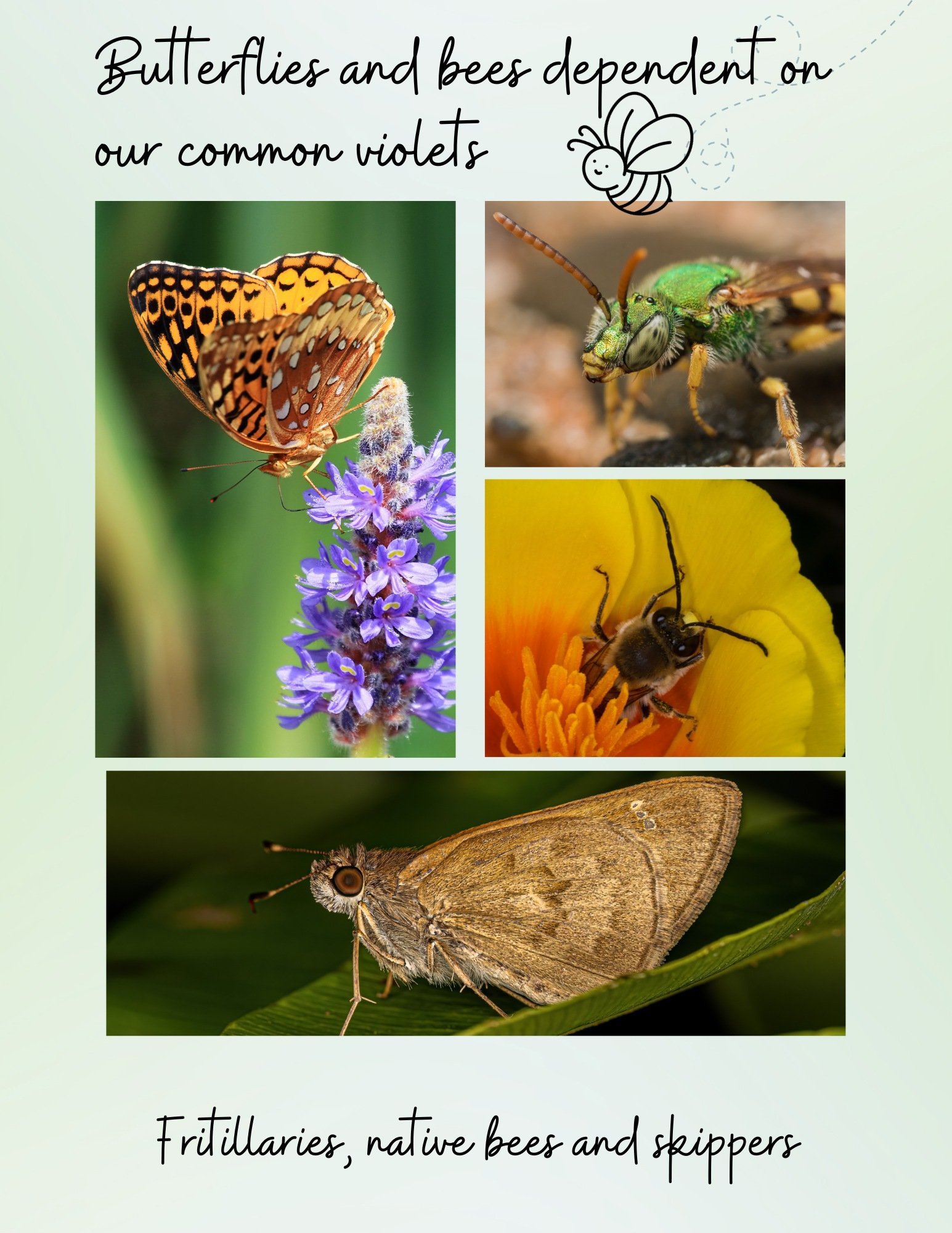What are the benefits to growing native violets?
Native butterflies depend on our common violets
In our garden, common native violets are welcome wildflowers.
Whether they are growing happily in the grass or adorning wild areas of the garden, common violets will always have a home here.
I extol the virtues of commonplace violets due to their critical and pertinent role within our local ecosystems. Their vivid purple, yellow and white blooms are a delightful signal that spring has arrived, leading the way for other native wildflowers, which will continue to flourish right through to the summer.
But it is not just their charming appearance that makes them essential; it is their ecological significance that truly stands out.
These little plants serve as host for many butterfly species, particularly the fritillaries, as well as a range of essential insects. This interaction guarantees the perpetuity of these species. Recognizing the significance of this relationship is vital and therefore we should resist the impulse to remove these wildflowers from our yards.
Their presence is not just an aesthetic addition to our landscapes; it is a fundamental factor in ensuring the survival of our native wildlife.
Moreover, I must highlight that violets are not just a symbol of spring. They bloom from the early days of spring continuing into the colder months, bringing colour and life to our gardens even in early winter. This makes them not only a visual treat but also a constant source of sustenance for a variety of local insects and pollinators.
Rather than eliminate them, we need to applaud and appreciate the remarkable roles of such ordinary plants like the violet, in contributing to the biodiversity of our ecosystems.
Our common native violets are host plants to many charming fritillary butterflies such as the Great Spangled, the Aphrodite, Atlantis, Silver Bordered, and Meadow fritillary butterflies.
What does it mean to be a host plant mean, and why does it matter?
Host plants play an integral role in the sustenance of our indigenous wildlife. They are crucial in providing nourishment for the larvae of butterflies and other insects.
The colourful and captivating butterflies we so cherish are in fact bi-products of these caterpillars who, in their initial stages, rely heavily on these host plants for their sustenance and habitat.
However, the fascinating metamorphosis from a caterpillar to a butterfly is a process that requires a bit more elaboration. During this transformation, the host plants serve as the primary source of food and nutrients for the caterpillar. They also provide the much needed sanctuary for these creatures to grow and develop safely.
A prime example of a host plant would be common violets, these nurturing plants are known to host a variety of butterfly species.
In order to conserve these vital host plants, one simple practice we can adopt is to discourage the unnecessary weeding of our gardens and lawns. By preserving these plants, we provide more than just a home for caterpillars, we are supporting the lifecycle of butterflies, and in turn, the vibrancy and balance of our native fauna and flora.
The critical role host plants play is undeniable. Not only do they foster growth and development for caterpillars, they are instrumental support systems to our indigenous fauna and flora.
Where are common violets found?
The common blue violet (Viola sororia), also known as common meadow violet, purple violet, woolly blue violet, or wood violet grow in a wide range across eastern North America in the United States and Canada in areas ranging from zones 2 through 11.
A similar violet (Viola odorata) is a species in the viola family, native to Europe and Asia. Commonly known as wood violet, sweet violet, English violet, common violet, florist’s violet, or garden violet, this small herbaceous perennial has been introduced into North America and Australia.
Although our common blue violet are best known for their spring blooms, common violets can grow from spring into winter, making them extremely important wildlife plants.
There exists a wide variety of 35 Viola species throughout Canada, from the Atlantic to the Pacific Ocean, extending up to the northern treeline. These include varied habitats such as forests, prairies and marshlands. A notable species is the green violet (H. concolor) frequently seen in southern Ontario.
As we said earlier, these Viola species play a crucial role as host plants to a myriad of fritillary butterfly species. Preserving these plants will significantly aid in the survival of our native wildlife, particularly our cherished butterfly species.
Within the realms of the United States, the humble common violet has embedded itself in the core of its native ecosystems. The plant serves as a host to an array of Fritillary butterflies. The importance of its preservation is paramount. The robust flower thrives in zones 2 to 11, surviving from spring to winter, acting as a reliable food source for larvae. As such, it is imperative to reorient our gardening approach from removing these perceived ‘weeds’ to fostering these foundational aspects of our biodiversity.


